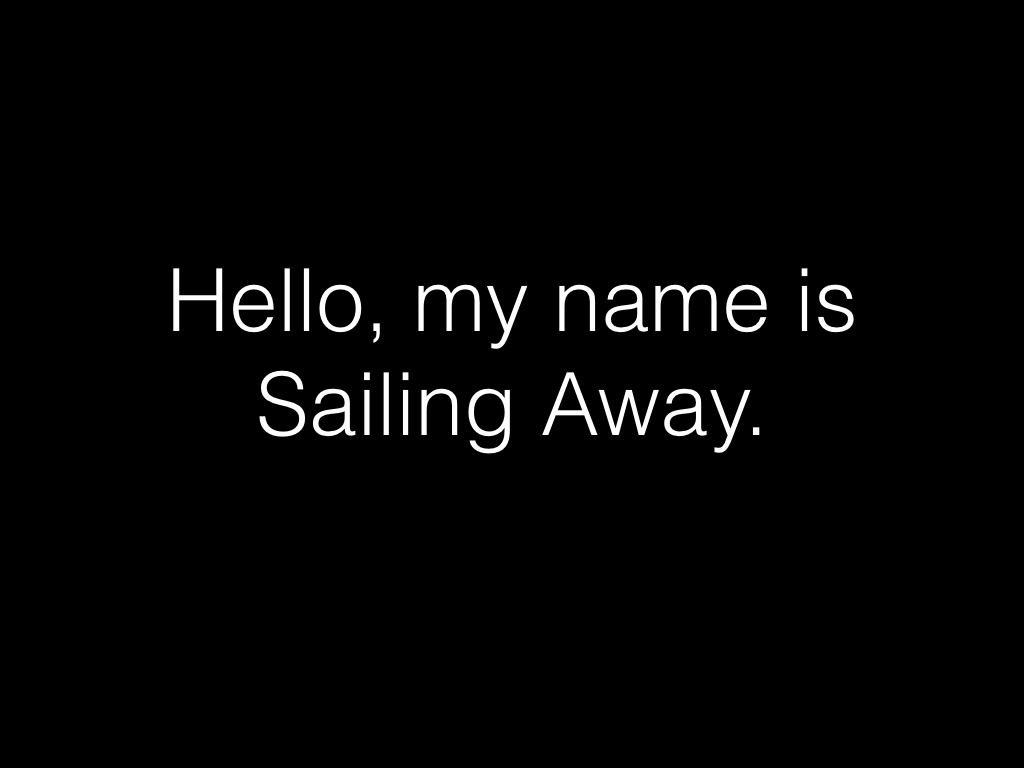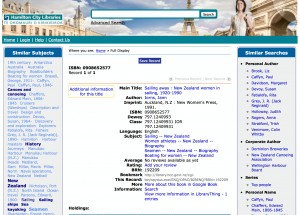Hello, my name is Sailing Away
Hello there!
My name is Sailing Away: New Zealand Women In Sailing, 1920-1990. I’m a text artefact from August 1991. Actually I’m one of 2,000 identical paperbacks printed in Hong Kong under identifier ISBN 0908652577. I have a soft gloss cover. My interior is codex; an index and 168 paginated sheets.
I have a story. Initially I was shipped from Hong Kong to New Zealand for the publisher’s launch and then I’ve been in and out of hands (and boxes) ever since. I was on a coffee table, then a bookshelf, then in a second hand bookstore, on another bookshelf and now I’m in a ‘waiting place’ while the internet figures out what to do with me. I seem to be listed on one of those Amazon web stores and it’s telling everyone I’m worth USD 9.88 when really I’m worth NZD 29.95.
Another of my group is on the AntiQBook web store. Her value is NZD 20.00 which is not so bad, although still not right. Whoever is looking after her web listing hasn’t spelt our creator’s name correctly (so wrong!).
I quite enjoy this ‘mark down’ lifestyle even if it’s unpredictable and I never know who’ll touch me next. It’s just a whole lot different, I imagine, to my peers in the libraries. They seem to be valued because a library catalogue accurately describes the attributes of ISBN 0908652577. We’re a history title with substance, you know!
Still …. being in a library doesn’t guarantee security. A university library has traded in one of our lot for cash. So much for cultural preservation! I heard on the grapevine, too, that someone tried offering free PDF downloads of ISBN 0908652577 …. that’s a reincarnation of our essence.
Sure hope I get to meet a new reader soon. One who wants to treasure our creator’s words.
**********************************************************************
The above narrative was written after a reflection on Module 2 readings about the changing storage formats for text artefacts (printed text, microfilm, CD-ROM, PDF, e-Book), ownership of text artefacts, and the notion that libraries preserve cultural heritage by storing such artefacts and making them accessible for current and future generations.
A quote from O’Donnell’s The Virtual Library struck me as significant. “Reliance on texts implies that someone will own texts and they will be accessible: ownership and access remain central concerns in all discussions of the present and future of the library” (date unknown).
Who owns texts exactly?
The narrative shows how a book written and published 24 years ago is circulated as a ‘batch’ of identical copies, most of which experience a progressive change of ownership. Ownership begins with the author and publisher (under a contract), and then through commercial interests of the author and publisher splits to institutions (libraries) and retailers. Both libraries and retailers own the items they purchase and are free to do with them as they like. Retailers trade to individuals or move unsold stock to ‘remainder’ sellers, of which Amazon would be one. The individuals who buy from a retailer and own their copy of the book can choose to resell at any time … and so it goes on. Ownership is constantly changing for commercially circulated items.
Any copies that libraries purchase may well be preserved, but for how long? Libraries sell and give away text artefacts from time to time as storage costs for their assets become prohibitive. Members expect new items to be purchased and made available – so out with the old, in with the new.
The point I am making is that printed texts of worth exist outside libraries through the natural process of bulk circulation, therefore ownership of cultural heritage cannot rest with libraries alone. We are each responsible for preserving culture when we purchase and hold on to text artefacts. O’Donnell made such a point in saying ‘even the great depository libraries contain only a fraction of the printed reading matter of their own societies’ (date unknown). I wonder how many of us think of ourselves as preserving culture? How many of us store books in our homes with an expectation we will need to do this for eternity? Likely we pass on or sell our texts from time to time as we struggle to find space to store them.
In terms of accessibility of artefacts, there will be copies of printed texts accessible to those who have a will to find them. Printed texts circulate widely outside libraries, and more so since the arrival of the internet. Cultural artefacts don’t necessarily reside in libraries, so society is not necessarily beholden to libraries to provide access to them.
O’Donnell’s The Instability of the Text claimed ‘the new flood of electronic texts brings with it an exponential increase in the difficulties of making information available to users and preserving it over time’ (1999). New media technologies are replacing old media technologies, and with the change comes an inability to read ‘old format’ texts with ‘new format’ readers. This suggests some of our cultural artefacts will be lost.
O’Donnell may be right in suggesting there will be a problem with preserving electronic texts, but I ask if preservation is really that important? If so, for how long? In the case of the 2000 printed copies of ISBN 0908652577, it seems unlikely that a text focused on sailing history for 8 decades of the 20th century will still be relevant to society 30 or 50 or 100 years after publication. The book captured social change for women in a time when it was relevant to capture that change. The future will have different issues to report.
Ownership, accessibility and preservation are interconnecting themes and at the heart of these themes is the concept of ‘cultural value’. Who determines that value? If it’s individuals, then which artefacts will each of us value enough that we will take responsibility for preserving them? If it’s institutions, then who in those institutions will determine cultural value of all the texts produced and circulated?
Currently, anyone can preserve texts created electronically in a hard copy format and keep that format for as long as desired. To me, this suggests that our focus should not be on new technologies and how their outputs are subject to loss with advancement of newer technologies, more to raising awareness of the need for the software industry to preserve programming of print functionality as it moves forward.
References:
O’Donnell, J. (date unknown). The Virtual Library: An Idea Whose Time Has Passed. University of Pennsylvania.
O’Donnell, James J. (1998). The instability of the text. In Avatars of the Word. From Papyrus to Cyberspace. Cambridge, MA: Harvard UP, pp. 44-49.




What an interesting post! I think it really shows that there is no way to predict which books will be saved. When a library, or even an individual, is making a decision about which books to keep and which to give away they make that decision based on what they judge to be most important at that time.
Additionally, with all of the digital items being produced do we need to keep all of them? Will they all be relevant or even looked at in the future? They are interesting points to consider. I do worry, however, that there may be no record of everyday life if future historians are unable to decode the writings and photographs of our society.
“Currently, anyone can preserve texts created electronically in a hard copy format and keep that format for as long as desired.”
Don’t forget about the rapid changes in technology and the obsolescence that follows. It is huge and expensive task to update older digital formats and/or digitize physical copies of things.
As new information is being created at unprecedented rates, who is going to take the time to reformat old material? How do you decide what is worth keeping?
Agree with you Jesse that not everything can be printed, or will be printed in future. I guess I’m referring to the ‘late age of print’ where we are ‘scanning’ as a means of reproducing something we once would have printed on paper.
What does the future hold for librarians? In my current school our librarian is cut back to 2 days a week? I find this disturbing.
In your posting you question who will determine the artifacts we value enough and take responsibility for preserving them? I believe this makes the future role of librarians an even more important one. The traditional way we view librarians will have to change. Librarians will need to be highly trained and specialized individuals. They may have different titles, but those individuals who are culling digital media play the same role as the librarians culling your school library. And cull we must!
I believe there is hope. I believe through digitizations we are preserving more text than we ever have. At least we have access to more print than we ever had before. The gap as to who can access text is also narrowing. In the article “Scan this Book!”, Kevin Kelley (2006) points out that through digitizing print we are able to cross link and interconnect text, so these historical texts or artifacts, at least the most relevant or most referred parts of historical text, will be preserved through links with related text or cross content material to those people that are most interested in reading it. Not all will be lost!
I’m not sure how it’s done by librarians, but for ordinary folk, the tagging of content as it’s published online spaces helps everyone to find and connect information that’s held in different spaces. So long as we choose sensible tags (semantics), we hope the web can collect relevant information. I wonder as time goes by how much volume will attach to the tags we use now, and if there will eventually be issues with finding information that’s relevant to our needs? I guess our librarians have thought of this already!
Forgot to post my reference – sorry.
Kelly, K. “Scan this book!” New York Times 14 May 2006. Retrieved from http://query.nytimes.com/gst/abstract.html?res=9C03E2DD163EF937A25756C0A9609C8B63&pagewanted=1
What a marvellous post! I really appreciate your narrative outlining the fate of a lonely paperback book. It really illustrates just how much goes into the printing and (re)distribution of print.
I also made the connection to the parallels and differences between print and digital media access. While digital media, like you say, is able to be saved across different types of technology and, presumably, saved and accessed easily for years to come, Jesse brings up a good point about the ever-changing technologies in this regard. Many of these are going by the way-side, becoming “too old” and inaccessible, or are just being overshadowed by the bigger and better.
You ask a very relevant question with regards to text and technology, whether it is important for all texts to be saved forever, and specifically a text on sailing history for 8 decades of the 20th century. The answer to this question is riddled with different opinions, I’m sure, but with regards to the text in question, I think it is very important to save this bit of history in one way or another. Yes, the ‘people of the future’ will likely be more interested in the current sailing techniques or stories, but I think that history will always have a place in the future and it’s important to preserve as much information from the last as we can. If this means scanning all print books so that the digital copies can be housed in a digital library more easily than a print copy in a traditional library, then let’s do it! The question then becomes, what about all of those print books that have disappeared due to (*insert natural disaster here*) that we will never preserve copies of? Well, I guess we’ll never know since they have presumably disappeared.
This is just the opinion of a girl who has always dreamed of having a “Beauty and the Beast”-type library in my future mansion – but I think books, whether print or digital, and just too precious to let disappear.
When you mention disasters I couldn’t help but think of the Slave Lake fire (see http://www.theglobeandmail.com/news/national/slave-lakes-new-library-a-casualty-of-devastating-blaze/article1322344/).
There is one other aspect of the travels of a book and that is as a donation. Many libraries will collect used books to be sent to developing countries. So while we may find interest in the paper formats waning in our areas there may be a growth in the ‘recycling’ of these used reading materials in other areas of the globe. This may also be true of aging technology.
Back in the olden days there was Dick and Jane in our school systems.
https://en.wikipedia.org/wiki/Dick_and_Jane .
Maybe one positive reason for not destroying, ‘culling’ old media including books is that they will eventually come full circle to be in vogue again. Just think about how Disney has recycled its animations for limited time offers.
Terry